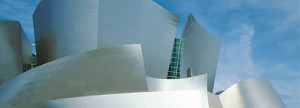The Los Angeles Philharmonic opened its 10th-anniversary celebrations for Walt Disney Concert Hall on Sept. 30 with a most unusual program led by Gustavo Dudamel and starring cellist Yo-Yo Ma.
The program was devised to highlight the world-class acoustics of what Dudamel called “this miraculous space.” Disney Hall was itself the program. Architect Frank Gehry and acoustician Yasuhisa Toyota were in attendance, as were members of the Disney family.
Video artist Netia Jones, known for augmenting operatic and concert performances with projected images, used three large screens hung from above at odd angles in the hall. Between pieces, we heard recorded excerpts, some of them quite colorful, of Gehry speaking about the project.
Walt Disney Concert Hall is an iconic structure of the Los Angeles cityscape and over the past 10 years has proven itself as a world-class music performance space. The program was designed to push the limits of the hall to its extremes, starting with silence as the first demonstration.
John Cage’s 4′33″ (Four minutes, thirty-three seconds) is not the typical fare of a symphony hall. The piece was composed in 1952 to be not played by any collection of instruments. This performance was likely one of the largest ever orchestrated. Legendary cellist Ma joined as a soloist — his silence radiated throughout the space; his face dreamily gazed upward in his characteristic pose. Dudamel kept the first movement short, and his direction was gentle, occasionally only an individual digit filled the time. The second movement was more substantive, and the normal shuffling in the audience between movements was missing. Concertmaster Martin Chalifour and the strings stayed on the boundary between intent and touch, building an expectation that accumulated in the pregnant quiet moment. A dynamic gradient emerged. Dudamel gestured with a relatively large punch to end it. Interestingly, there were very few sounds from the audience — no murmurs, no phones, very few coughs. There were no sounds from the street, no vibrations from the outside world, above or below. The silence of the capacity crowd was impressive; I think we understood the moment because Dudamel and the orchestra made the performance effortful. The nothing was itself a music we rarely hear. The LA Phil found a way to breathe dynamic into the silence, to really mean the communication and to use it to demonstrate the quiet depths of Disney Hall.
Ma then masterfully spun Bach’s Cello Suite No. 3, Prelude, with its flowing arpeggios, into a stunning statement. He broke the silence with the purest of sound. The contrast was stark as he filled the hall with his soulful artistry. Ma followed with a graceful playing of Tchaikovsky’s Rococo Variations for solo cello and orchestra. His melodic lines were suggestive of the contours and rhythms of the hall design, an illusion strengthened by the images of Gehry’s models and sketches shown on the screens. There was a rhythm of form that expressed a sort of fluidity of thought, with contours and continuity, shifting in an ever-evolving model. Ma’s tuneful dance continued picking up heat in Russian and French variations, then a dramatic cadenza pushed the technical envelope of his cello to its edge. Oh, Ma, what exuberant energy! Bravo!
Thomas Adès’ These Premises Are Alarmed is difficult to describe in normal musical terms, but think of three or four minutes of highly charged, densely packed sound — the antithesis of Cage’s 4’33”. Dudamel and the orchestra grabbed our attention from the first sounds, then dunked us into an intense flow of energy that never let up from a large orchestra with fortified winds and all of their family cousins and a huge percussion section that included roasting tins in its arsenal. I can think of no better way to “proof” Disney Hall.
The third movement from Mahler’s Ninth Symphony, Rondo-Burleske, added some classic drama to the night. Jones’ video presentation accompanied the music with images from newspaper headlines proclaiming the project on the brink of failure and collapse — a scenario not uncommon in Los Angeles. Mahler’s symphonic drama fit the video well, but the semantic concreteness of the superimposed images changed the character of this beautiful music.
The concert closed featuring the magnificent organ in Saint-Saëns’ Symphony No. 3, with Joanne Pearce Martin perched on the lofty keyboard. At one point, I could see the brass huffing, the strings slashing, the winds blowing and the percussion shaking — all totally masked by the organ — that instrument is a beast. For the sake of witnessing this extraordinary power, I will forgo a judgment on musicality on this occasion. Think of it like taking a high-performance car for a spin — you are going to break the speed limit and enjoy it.
The pseudo-encore was a warm and heartfelt acknowledgement of Walt and Lillian Disney. With the family in the audience, and their portrait on the screens, the orchestra played the traditional arrangement of “When You Wish Upon a Star.” The strings were beautiful, especially in this space, and the tune is so culturally iconic that there were very few dry eyes in the house.
Happy birthday to Walt Disney Concert Hall — 10 years old — and all grown up!
Bravo! And a toast to the Disney family and all of the players who made this dream come true.
~Theodore Bell, Culture Spot LA
For a calendar of upcoming concerts, visit www.laphil.com.






